Explore effective control of impurities in pharmaceuticals, covering sources, types, challenges, and regulatory guidelines. Learn advanced analytical techniques and real-world case studies to enhance drug quality, safety, and efficacy
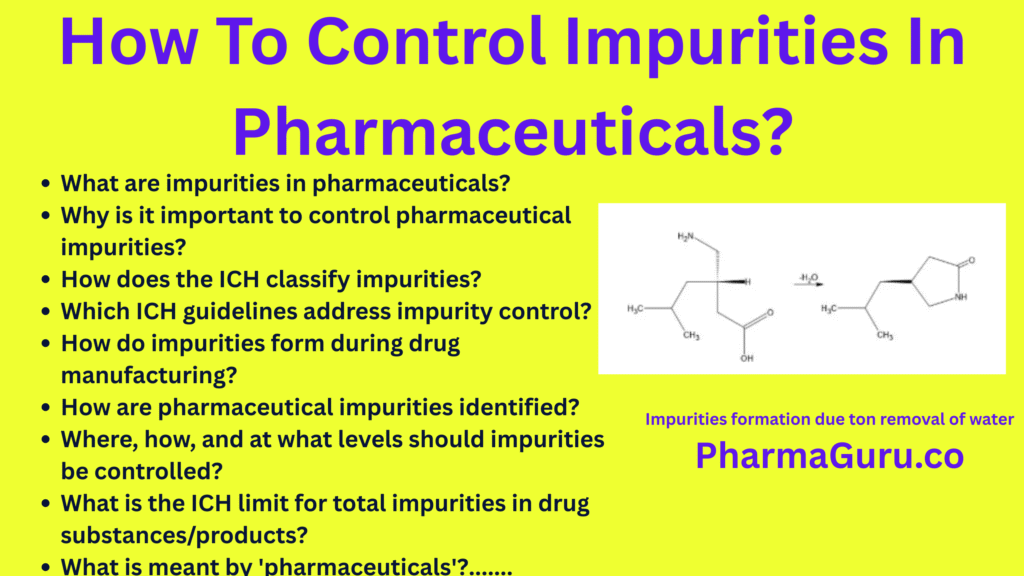
Impurities in pharmaceuticals are unintended chemicals that may originate from manufacturing processes, storage conditions, or degradation. They include organic compounds, inorganic substances, and residual solvents, and can adversely affect a drug’s safety, efficacy, and stability.
The control of impurities in pharmaceuticals is a challenging task in the pharmaceutical industry because it directly influences the quality, safety, and efficacy of Pharmaceuticals. Minimising impurities in pharmaceutical products is essential for ensuring that medications meet the highest standards, both for patient health and regulatory compliance. The lower the level of impurities, the better the pharmaceutical product is perceived in terms of both quality and safety.
However, controlling impurities presents a significant challenge for pharmaceutical companies. This complexity arises from the variety of impurities that can be introduced during the manufacturing process, from raw material sources to production, packaging, and storage. Additionally, the demand from consumers and regulatory bodies for pharmaceuticals with minimal or no detectable impurities adds further pressure on manufacturers.
Some customers, especially those with highly sensitive health conditions, require pharmaceuticals that are virtually free from impurities. As such, an effective strategy for impurities control is not just a regulatory requirement but also a competitive differentiator in the market.
In this article, I will discuss the concept of impurities in pharmaceuticals, including their sources, types, and the challenges associated with their control. We will also discuss the guidelines and best practices for managing impurities, as well as the advanced analytical techniques used to detect and quantify them. Through case studies, you will gain insights into real-world applications and learn how different companies have addressed impurity challenges. Finally, we will address frequently asked questions to provide a comprehensive understanding of impurities control strategies in the pharmaceutical industry.
Major Takeaway: FAQs on Impurities In Pharmaceuticals
ICH has classified impurities into three categories, Organic impurities, Inorganic impurities and Residual solvents.
It may be solvents used in the process( like acetone, acetonitrile etc.) or starting material or intermediate stages or contaminants
Any component of drug substance that is not the chemical entity defined as drug substance is called impurity. Impurities classified into organic impurities, Inorganic impurities and Residual solvents.
Organic volatile substances like methanol. Ethanol, toluene, acetonitrile etc. used in the manufacturing of pharmaceutical substances are called residual solvents.
Common sources of impurities in drug substances are key starting material or starting material, purchasing materials, intermediates, process related impurities, contamination, storage condition and packaging material
Area % method and external standard method are widely used in the industries to calculate the impurities. In few cases internal standard method is also used to calculate the impurities.
Isomeric impurities such as chiral isomers, rotamers, tautomers and structural isomers (positional and geometric) present in pharmaceutical products.
Pharmaceutical products decompose on storing due to the presence of heat, air, light and oxygen
HPLC, GC, GC-MS,LC-MS Preparative HPLC, FTIR, UV spectrophotometer and NMR are the common methods and techniques used for the identification and quantification of impurities in pharmaceutical products.
The ICH limit of unknown impurity is not more than 0.10%. If the structure is known in that case limit of the impurity will be 0.15%.
The total limit should be kept based on the trend data. ICH does not say anything about total impurities
No. Related substances deal with only process-related impurities, whereas impurities contain all types of impurities.
Starting materials, byproducts, intermediates, reagents, ligands, catalysts and degradation products come under the organic impurities in drug substances and drug products
The total acceptance criteria are decided based on the trend data, impurities present in the innovator’s samples and pharmacopoeia monograph
The process of acquiring and evaluating data that establishes the biological safety of an individual impurity or a given impurity profile at the level(s) specified is called the qualification of the impurities.
The common factors affecting impurities in pharmaceuticals are temperature, light, air, moisture, storage condition and packaging condition
ICH guidelines Q3A(R),Q and 3 B (R2) ICH Q3C refer to impurities
Molecules used in the diagnosis, treatment or prevention of disease or in the manufacture of drug substances or drug products are called pharmaceuticals.
The manufacturers of drug substance develop a vision based strategy to ensure effective control over the level of impurities in the Active pharmaceutical ingredients (APIs) and this is called Impurities control Strategies (ICS)
Preparative HPLC, Flash chromatography, Thin layer chromatography (TLC), Column chromatography, and Extraction (Liquid – Liquid extraction or Liquid-Solid extraction) are widely used for the isolation of impurities
Several factors like trend analysis data, purification power, nature/toxicity and type of impurities are considered while setting the impurities limit
Class-1 contains Arsenic (As), Lead (Pb), Cadmium (Cd), and Mercury (Hg). Class-2A contains Cobalt (Co), Nickel (Ni), and Vanadium (V) elements
Any component of a drug substance that is not the chemical entity defined as the drug substance is called an impurity. For a drug product, any component that is not a formulation ingredient is called an impurity.
Impurities in APIs (active pharmaceutical ingredients) or drug products can form due to synthesis, manufacturing processes, degradation during storage, exposure to heat or light, due to packaging conditions and contamination.
The manufacturers of drug substances develop a vision-based strategy to ensure effective control over the level of impurities in the Active pharmaceutical ingredients (APIs). This is called the Impurity Control Strategies. It includes the detailed procedure to control the impurities in the manufacturing process, i.e. what is the source of impurities, what is the nature of the impurities, how impurities will be isolated and characterized, where impurities will be controlled and at what level impurities will be controlled.
If an impurity has therapeutic value then it is considered as a pharmaceutical. However, most of the impurities have no therapeutic value and hence reduce the quality, safety and efficacy of the medicine. That is why control over impurities in pharmaceuticals is necessary.
For example, Cefuroxime Axetil is the mixture of Cefuroxime Axetil diastereomers A and B. Both A and B have therapeutic value.
Due to the following reasons control of impurities is required in pharmaceuticals:
For example, Genotoxic impurities like N-nitrosodimethylamine NDMA, N-nitroso diethylamine (NDEA), N-nitroso-N-methyl-4-amino butanoic acid (NMBA), N-nitroso isopropyl ethyl amine (NIPEA), N-nitroso diisopropylamine (NDIPA), Nitrosodibutylamine (NDBA), and N-nitroso methyl phenylamine (NMPA) are highly toxic and the same should not be present in pharmaceutical products
The Thalidomide tragedy was one of the darkest episodes in history. Thalidomide is a chiral molecule and it contains two isomers, R-Thalidomide and S-Thalidomide. R-Thalidomide is biologically active whereas S-Thalidomide is Teratogenic in nature. Initially, it was not prepared as a pure form (R-Thalidomide and it was prepared as a racemic mixture due to various limitations (like Analytical and synthetic technique limitations). The S-Thalidomide present in the Thalidomide drug was the source of the Thalidomide tragedy.
The following are the main sources of impurities in the pharmaceuticals:
ICH has classified impurities into three categories, Organic impurities, Inorganic impurities and Residual solvents (OVIs). The following is the details of the impurities classification
The following are the route of synthesis of paracetamol and its different impurities
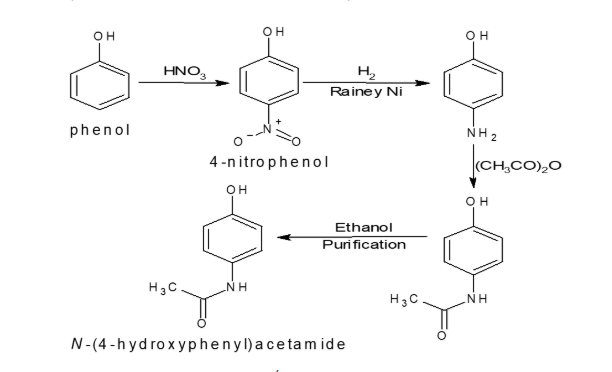
The following are the different types of impurities and their sources of above paracetamol process;
| Molecule Name | Source | Type |
| Phenol | Starting material | Organic impurity (Process related impurity) |
| 4-Nitrophenol | Intermediate | Organic impurity (Process related impurity) |
| 4-aminophenol | Intermediate | Organic impurity (Process related impurity) |
| HNO3 | Purchasing material | Residual solvent (Inorganic) |
| Raney Nickel | Purchasing material | Inorganic impurity |
| (CH3CO)2O | Purchasing material | Residual solvent (organic) |
| Ethanol | Purchasing material | Residual solvent (organic) |
The following guidelines are very helpful while controlling the impurities in pharmaceuticals
The following terminology relates to impurities and is widely used in pharmaceutical industries:
Molecules used in the diagnosis, treatment or prevention of disease or in the manufacture of drug substances or drug products are called pharmaceuticals. It may be API, dosage form, starting material or key starting material
Active pharmaceutical ingredient (API) is the biologically active component of a pharmaceutical product (tablet, capsule, cream, injection) that produces the desired effect.The is the main ingredient in medicine. Medicines may contain one or more than one APIs. Each API acts in different ways in the body
DS (drug substances) and Active pharmaceutical ingredient (API) are the same
There are several steps involved in the manufacturing of desired pharmaceuticals. The steps which are isolated and some testing like impurity profiles, assay etc are performed are called intermediates.
The (n-1) isolated step is called Penultimate Intermediates, where n is the desired pharmaceutical.
In addition to the desired pharmaceutical/intermediate unwanted side product may form during the reaction. That side product is called by-product. By-product also acts as an impurity and it is purified in the process. Some time it is also called Transformation products. In the paracetamol process By-product is formed by the following mechanism:
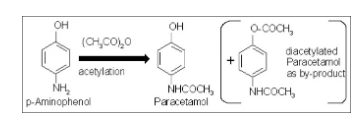
The impurities formed due to degradation of pharmaceutical is called degradation products or degradants. Generally degradation products are formed due to heat, light, storage etc.
The unwanted optical isomer is considered as a chiral impurities
The impurities that are formed during synthesis due to raw materials, solvents, intermediates and by-products are called Related impurities or related substances.
Generally, Inorganic impurities form during manufacturing processes and the source of these impurities is the equipment used in the manufacturing process. for example Heavy metals, ligands, and catalysts
The source of Organic Volatile Impurities (OVI) is the residual solvents used in the manufacturing process
A raw material, intermediate or an API that is used in the production of an API and that is incorporated as a significant structural fragment into the structure of the API is called a key starting material
The study in which the impurities of the previous stage are examined in the present stage and their absence or control is proved is called a carry-over study. This is a one-time test or in some cases a skip test is done. Secondly, in carryover testing, only Verification is performed.
Impurities can form in a variety of ways during pharmaceutical synthesis. The following are some common mechanisms of formation of impurities in pharmaceuticals:
Hydrolysis is a common phenomenon for the ester type of drugs. During hydrolysis, ester is converted into alcoholic impurity by the following mechanism:
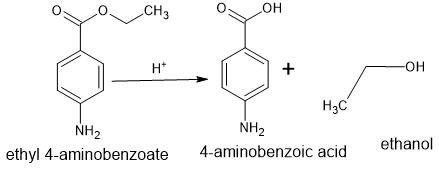
In decarboxylation, the -CO2 functional group of the drug is removed and impurity is formed. This impurity is formed in those pharmaceuticals which contain a carboxylic group by the following mechanism:
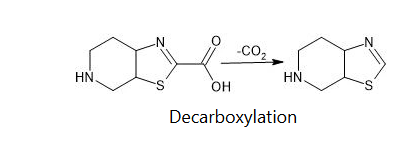
In dehydration, the water of the drug substance is removed and impurity is formed. Pregabalin lactam impurity is formed by the removal of water from the Pregabalin by the following mechanism:
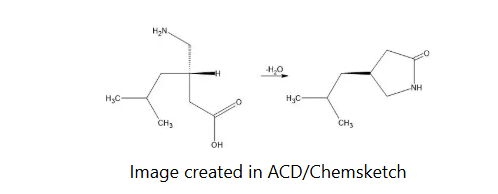
Pregabalin has therapeutic value whereas Pregabalin lactam impurity is toxic.
Racemization impurity form in chiral drug substances. It depends upon the following factors:
For example, when Ezetimibe is prepared by a chemical process, the RRS isomer is formed in greater quantities than when it is prepared by an enzymatic process.
Typical drug substances in which racemisation impurities form in the process: Edoxaban, Atorvastatin and Anacetrapib
Formulation-related impurities may form due to the following reasons:
The following approaches should be applied to identify the unknown impurities:
Impurity synthesis is a challenging task and acts as an individual project. If an impurity is known then it can be synthesized or purchased from the market. But if an impurity is unknown then it needs skill-based expertise as well as a lot of work for isolation, characterization and control.
Isolation of impurities depends on various factors such as polarity, structure, physicochemical properties and availability of the Analytical tool. Generally, Preparative HPLC, Flash chromatography, Thin layer chromatography (TLC), Column chromatography, and Extraction (Liquid – Liquid extraction or Liquid-Solid extraction) are widely used for the isolation of impurities:
Preparative HPLC is one of the widely used tools for impurity isolation. The goal of preparative-high-performance liquid chromatography (prep-HPLC) is to separate trace amounts of a pure compound as easily as possible in the most economical manner. Its principle is similar to that of HPLC. Columns with larger particle sizes are used in preparative HPLC.
Flash chromatography is a purification technique that uses glass columns filled with silica as the stationary phase and a solvent – either polar, non-polar or a mixture of the two depending on the polarity of the compounds to be separated.
Investigation is often done by UV light or iodine vapour to detect most organic substances. To extract material from plates, the simplest method is to scrape off the sorbent containing the material of interest and extract it with a suitable solvent, followed by filtration or centrifugation. The solvent is removed to collect the desired substance. If aluminum plates are used, cut and discard the sample.
Supercritical fluid extraction provides an ideal means of isolating impurities, due to high solute diffusivity, low viscosity and excellent solvent properties, they provide an excellent means of separating impurities and other compounds of interest in a short time. Carbon dioxide is most commonly used for SFE due to its availability, ease of use, and disposal. Ammonia and n-heptane can also be used.
Column chromatography is a traditional technique used to purify compounds based on their polarity or hydrophobicity. In column chromatography, a mixture of molecules is separated based on their differential partitioning between a mobile phase and a stationary phase. Column chromatography in normal phase mode is widely used for isolation of impurities.
Once an impurity is isolated then work starts for characterisation of the same. Characterisation of an unknown impurity is a challenging task and it needs a lot of work and expertise. The selection of the instrument depends upon the cost, limit of the impurity and the sensitivity of the impurity. The analytical instruments like FTIR, UV, HPLC, LC-MS, GC-MS, NMR, Elemental analyser, ICP-optical emission spectrometry (OES), ICP-mass spectrometry (MS), TGA and XRD are to identify and characterize the unknown impurity.
FTIR: It gives the functional and structural information group information of the impurity/molecule
GC-MS: It gives mass and structural information of the volatile molecules. GC gives both qualitative purity and quantitative purity of the compound.
HPLC-MS: It gives mass and structural information of the non-volatile molecules. HPLC gives both qualitative purity and quantitative purity of the compound.
NMR: It gives complete structural information about an unknown impurity like the number of protons, number of carbons and their nature.
An elemental analyzer is an instrument that can determine the elemental composition of a sample. The analyst may simply determine which elements are present, or it may perform quantitative analysis to identify how much of each element is present. In some cases, the isotopic composition can also be determined.
It gives UV spectral information and wavelength maxima of the molecule.
Taking the help of all the above instruments an unknown impurity is characterised and the potency of the impurity standard is calculated. The following formula is used to calculate the potency.
Potency = Purity – (Sulphated ash/residue of ignition + Loss on drying/water content/residual solvent + counter ion) etc..)
The following approaches are used in the industries to control the impurities:
An integrated approach encompassing all steps of the entire synthetic process and the types of impurities at each step should be taken into account when deciding on impurities control strategies:
Follow the following steps to control impurities related to SM/KSM:
Follow the following steps to control impurities related to purchasing materials:
Follow the following steps to control impurities related to Process related impurities:
Follow the following steps to control impurities related to Isomeric impurities:
Follow the following steps to control impurities related to Residual solvents (OVI):
The following are the ICH classification of the Elemental Impurities:
| Class | Impurities | Toxicity |
| Class -1 (contains 4 metals) | Arsenic (As), Lead (Pb), Cadmium (Cd), and Mercury (Hg) | Human toxicant |
| Class -2A (contains 3 metals) | Cobalt (Co), Nickel (Ni), and Vanadium (V) | Route-dependent human toxicant. High probability of occurrence in drugs |
| Class -2B(contains 10 metals) | Silver (Ag), Gold (Au), Thallium (TL), Palladium (Pd), Platinum (Pt), Iridium (Ir), Osmium (Os), Rhodium (Rh), Ruthenium (Ru) and Selenium (Sc) | Route-dependent human toxicant. Low probability of occurrence in drugs |
| Class -3(contains 7 metals) | Barium (Ba, Chromium (Cr), Copper (Cu), Lithium (Li), Molybdenum (Mo), Tin (Sn) and Antimony (Sb) | Relatively low toxicity by oral route. Limit: NMT 500ppm. |
Note:
Follow the following steps to control the Inorganic impurities:
To identify, characterize and control the Degradation impurities (DIs) is complex time time-consuming process. DIs should be identified, characterised and controlled using the following approaches:
Control of DNA reactive (mutagenic) impurities should be done based on classification
Impurities control strategies is have several advantages such as
DL: Non-adequate or poorly justified specifications proposed to control the quality of isolated intermediates (11% of all questions) and starting materials (7% of all questions).
The specificity should be maintained based on purification power and trend data. In this case, data was available up to 7% but the starting material limit NMT was kept at 11% without any justification. For this reason DL was given during review.
DL: Failure to adequately address the origin, fate, and carryover of related substances into the final substance. (4% of all questions)
Purification power or carry-over study must be performed then only a higher limit of any impurity can be kept. In this case without purification power or carry-over study higher limit (4%) was kept. That is the reason this DL was given.
Control of impurities in pharmaceuticals is a critical and complex challenge faced by pharmaceutical companies. In this article, we have explored the various types of impurities, their classification, and the strategies used to effectively control them through advanced analytical techniques. By understanding these concepts, you are now better equipped to design and implement robust impurity control strategies throughout the pharmaceutical development process. The importance of maintaining high-quality standards cannot be overstated, as it directly impacts product safety, efficacy, and compliance with regulatory requirements. Armed with this knowledge, you can contribute to ensuring the production of safe, effective, and reliable pharmaceutical products.”
Related:
Abbreviations
References
Quick Links